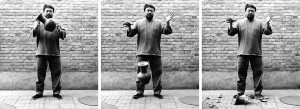Chinese contemporary artist Ai Weiwei’s prominence in the public eye is largely fueled by his absence. Unable to leave China since 2011 — after being held in detention for 81 days on tax evasion charges, following his extended inquiry into the Chinese government’s involvement in poor construction that contributed to the deaths of more than 5,000 schoolchildren in the 2008 Sichuan earthquake — Ai has since advanced his public profile with a number of international exhibitions and projects executed remotely. On September 27, @Large: Ai Weiwei on Alcatraz, a series of site-specific commissions within the historic former Alcatraz Federal Penitentiary will debut. Don’t expect to see the artist; he remains unable to travel, though his ideas will be everywhere.
It is fitting that Ai should explore the contours of history and personal freedom through a series of artworks in an infamous prison, site-unseen. He spent his childhood living with his family in exile, after his father, the poet Ai Qing, was sent to a labor camp for opposing the Chinese government. Following the Cultural Revolution, his family returned to Beijing and shortly thereafter, Ai began to explore his ideas as an artist.
For more than a decade he lived in New York’s East Village, studying at Parsons School of Design and the Art Students League of New York, before returning to China in the early ’90s. Mounting tensions around government restrictions began to fuel an underlying anger in his work — Dropping a Han Dynasty Urn 1995, a series of stop-motion photographs of the artist dropping an ancient relic, embody Ai’s frustrations with revisionism and censorship in governance.
In 2005 Ai began to experiment with blogging and offered daily doses of cultural criticism online for several years before Chinese authorities shut down his blog, following his outspoken criticism of the government in the wake of the Beijing Olympics (he was lead artistic consultant on the design of the Bird’s Nest stadium) and the Sichuan earthquake. Selected writings from his blog were later compiled into Ai Weiwei’s Blog: Writings, Interviews, and Digital Rants, 2006 – 2009, published by MIT Press. Since May 2009, he has been active on Twitter, as @aiww, and more recently on Instagram.
Social media, in many respects, has not only enabled Ai to continue his outspoken criticism, it has allowed him to gain further international recognition. In a 2010 video interview with The Guardian, he noted, “People often say that I started to become well spoken after a certain period, but it is all because of the Internet. If we didn’t have this technology, I would be the same as anybody else: I could not really amplify my voice.”


